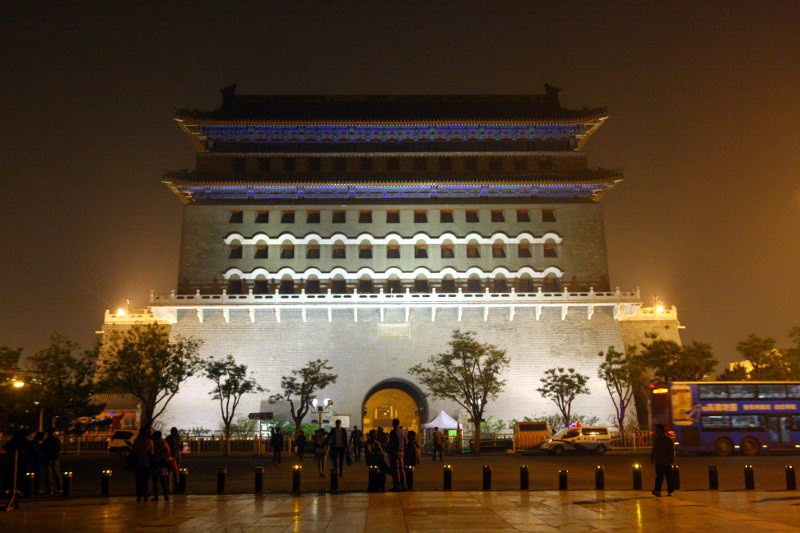It was a hot and sweaty night in the Nanjing airport. Cigarette smoke wafted across the waiting area in slow curls. Overhead, announcements were made that due to weather conditions, some flights were being cancelled. I waited, sweating, fervently hoping that my connecting flight to Beijing wouldn’t be cancelled. To much of my relief, it wasn’t cancelled, only delayed. I soon boarded my flight and arrived in Beijing, feeling very tired and worn out.
Exiting the airport, my travelling companions and I took a taxi to the hutong (胡同) where our boutique hotel was situated. To our dismay, the taxi driver simply dropped us off at the junction between the road and the hutong. His taxi couldn’t enter the small alley that is the hutong. At 1.30 a.m, we trudged into a dark alley, not even knowing where the hotel is – it was about 600m into the hutong. I was getting quite cranky at that point and my impression of China wasn’t very good at that point.
The next morning however, marked the beginning of a change of impression, of both Beijing and China on a whole. The booking of the boutique hotel was a good choice. In the light of day, I got to know the location, and it was impressive. The hotel is a siheyuan (四合院). The receptionist later intimated to me that it was built in the late Qing dynasty, making it about 140-170 years old. It was small (I would visit much larger _siheyuan_s later), but surely impressive. It was quite interesting to think about how a family would live in a building with such architecture and how the architecture of such buildings dictate social convention and dynamics in a family.
The Forbidden City
In Beijing, I visited the Forbidden City (紫禁城), more commonly called gugong (故宫), or former palace nowadays. It is by no means a small palace. In fact, it is the world’s largest palace complex – occupying some 720000 squared metres of area. It was used during the Yuan, Ming and Qing dynasties, and is in itself, a very large museum today, mostly regarding the Yuan, Ming and Qing dynasty. The subjects of the Qing dynasty was most prominent among the exhibits of the museum, owing partly to its recency (1644 – 1911).
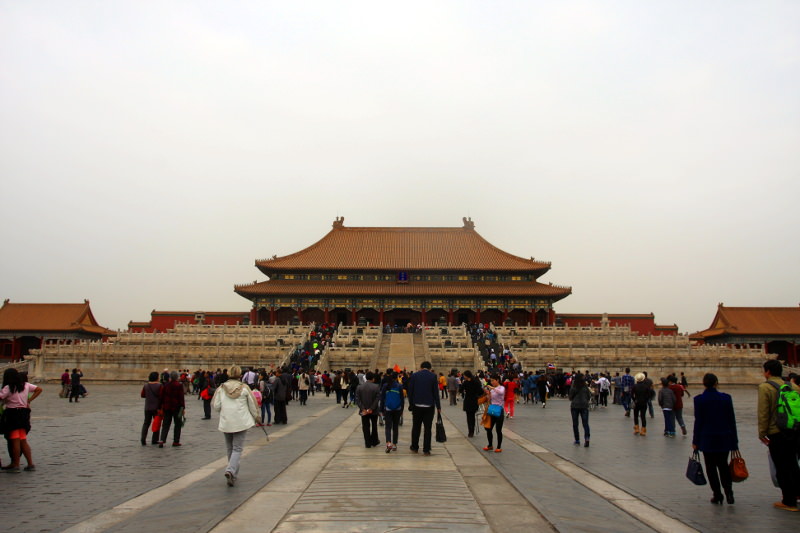
We spent an entire day in the Forbidden City, starting at 8.30 a.m and ending at 4.30 p.m and still hadn’t completed an entire tour of it. This should give you a sense of how terrifyingly huge the palace is. Of course, it was also partly my fault for dawdling around the exhibits, poring over every minute detail. If I had any regrets about that place, it would be not training my leg muscles hard enough, as by the end of the day, the mind is willing to explore, but the body says no. I would have loved to spend a few more hours in there.
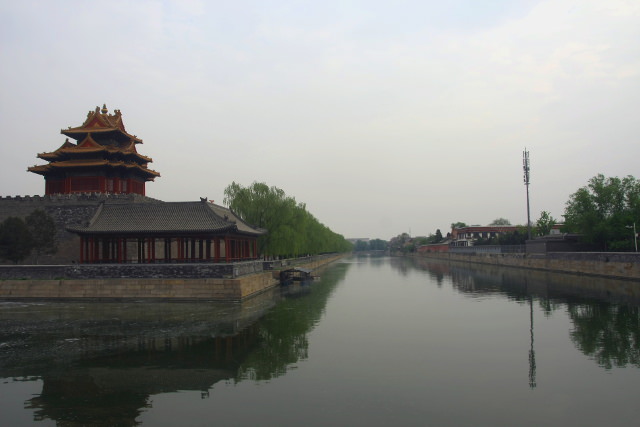
For what it’s worth, the automated audio guide was actually very good. I did find the Mandarin version a bit more overdramatic in voice reading (the narrator for example, gets audibly excited over the kind of wood being used and he kept raising his voice), while the English one was a lot more neutral. The English guide however, lacked quite a bit of trivia found in the Mandarin version – I do appreciate the reason for this though, since a lot of the trivia are connected to Chinese culture and can pretty much only be expressed in Chinese. The Mandarin audio guide was also presented more in a question and answer kind of way – I caught myself asking some questions, only to be answered by the audio guide, while the English version seem to be more a factual statement of things, and less of a Q&A kind of guide.
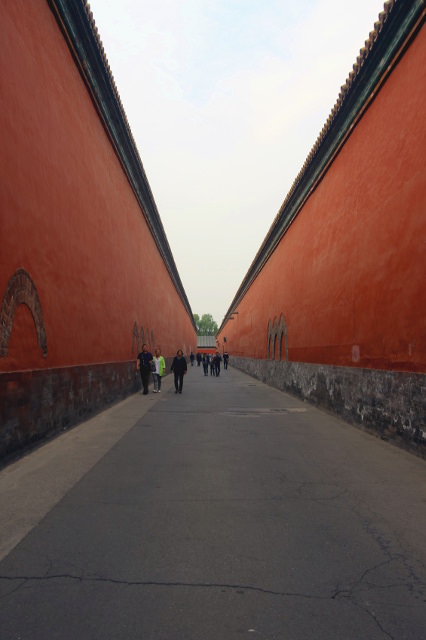
A pretty interesting fact that nobody seem to mentioned about the Forbidden City was the lack of trees in the main courtyards (there was an imperial garden in the Forbidden City of course). A historian later explained to me that this was intentional. Trees meant that would-be assassins would have hiding spots, making it a lot more difficult to protect the Emperor. Also of note were the large empty porcelain pots outside buildings – those pots used to hold large quantities of water, and acted a fire hydrants of the day.
Things I Thought About
-
The layout of the entire compound – there was somewhat of a logic to the layout (later I discovered that it was because it was built in accordance to the Book of Rites (liji (礼记))).
- The lives of the elites in the Qing dynasty.
- The architectural finesse in the buildings.
- The lineage of the Chinese language.
- The social dynamics of the different classes of people in the Qing dynasty
The Great Wall
There is a Chinese saying that goes, 不到长城非好汉 – If you’ve never been to the Great Wall, you’re not a real man. I made it to the Great Wall (well, a section of it called badaling (八达岭)), and it was, for a lack of better words, breathtaking.
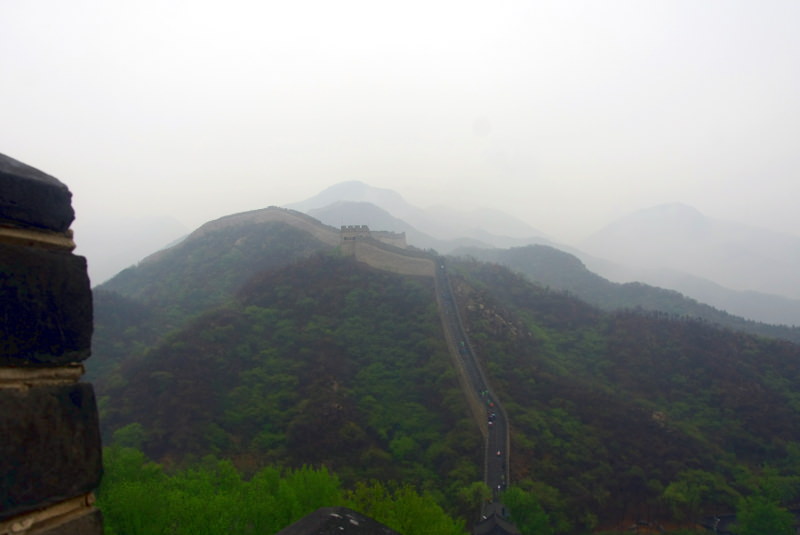
The Great Wall isn’t quite what I expected. I knew before hand that the Great Wall is more like several-long-walls-along-China,-and-not-really-consistent-in-build. But I had expected the steps to be small. And the slopes gradual. They were neither. The steps at the Great Wall are themselves inconsistent in height. Some steps are knee high, some are ankle high. The steps show signs of wear and tear. I took this photo for a statpics-esque view:
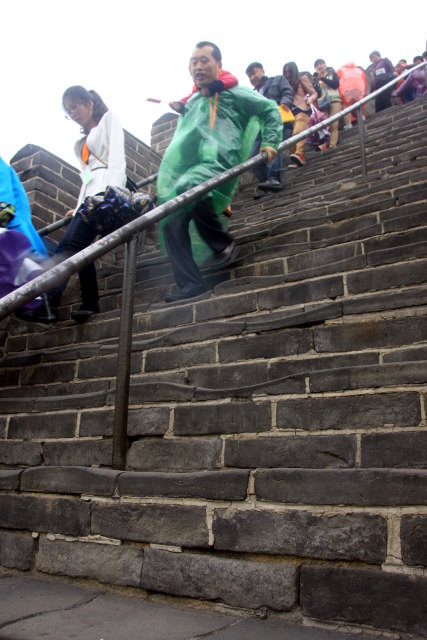
Another thing to be warned is that the pictures you see of the Great Wall are often deceiving. The slope of the wall is NOT gradual. Prepare instead for a climb more than a hike. Some parts of the Great Wall is indeed very steep. That was a bit of a daunting shocker when I was walking up the Great Wall. All that went through my mind was: holy shit this thing is steep.
It was raining when I went to the Great Wall, so that made things a little more challenging. Add to that, the hustle and bustle of so many people around, pushing about to get up and down. However, the sights were amazing. Sure, there were plenty of people in multicoloured ponchos dotting the scenery, but still it was a pretty sight. The camera really doesn’t do much in capturing the enormity of it (okay, sure, I could have used a 10mm lens, but it was raining and I only brought one lens to China).
The Great Wall was a pretty great beautiful place to visit. Our trip was cut short because we engaged on a day tour, whose tour guide only gave us 45 minutes to the Great Wall. The next time (yes, there will most definitely be a next time), I’d just not use a tour guide. And I would probably also avoid badaling. I would probably hike on the mutianyu (慕田峪) section instead.
Things I Thought About
- If computing were to be invented in China, we probably wouldn’t get as far as we would have today, due to its language complexities
- Fuck, this is a tough climb.
- Oh wow, the mountains look like Chinese paintings.
- I can’t imagine people doing this daily in the past. In full armour. Fuck this shit.
- How the hell did they get horses to get up here?
- Those barracks/grain store areas look pretty uncomfortable at night.
- Henry Kissinger’s Great Wall/snow shovelling story (this version is a little different from what I had in my memory, but the gist is similar).
- Mulan’s opening music when the Huns attacked.* Then I got down to business
Peking Duck
In Beijing, I had peking duck twice. Once at the original peking duck shop, quanjude (全聚德), and once at pretty much the best peking duck restaurant in the world, dadong (大董). The atmospheres are quite different, with dadong taking the fine dining and modernist cuisine route; while quanjude taking the traditional route.
I very much prefer the duck from dadong, however much of the quanjude experience derives from the history of the roast duck (and also, really, the world, considering a lot was done at quanjude when Nixon went to China. The dish was good, and the whole duck was used – the carcass of the duck was made into a soup as our last course. I also had the brain of the duck which tasted like a chalky paste.
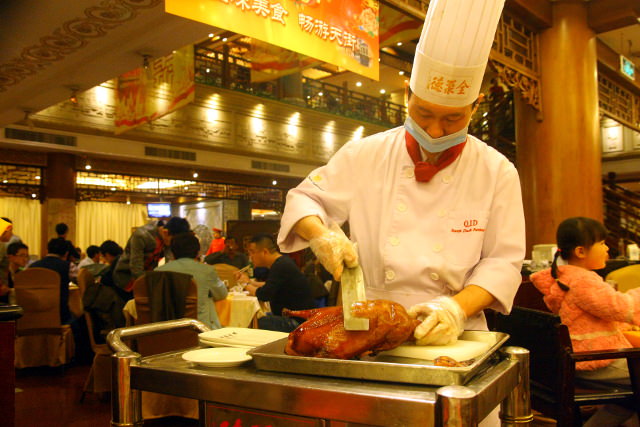
Things I Thought About at quanjude
- What is the oven temperature
- Peach tree wood is used – does it affect the flavour? Todo: Investigate
- Duck tongue is cold, and has a bite to it
- Efficient breaking up of queues into classes – big tables, small tables, etc. Automated pick up system(?)
On the other hand, dadong had a fantastic (not to mention very attractive) friendly waitress who took her time to explain every dish, how it was cooked and how to properly wrap the peking duck pancakes. I really enjoy these kinds of things, and dadong‘s duck is really very very very good. The duck skin was crisp, and yet melts in the mouth. The meat was not overcooked (a cardinal sin to me, when cooking poultry). It was pretty much perfection in a dish. There were also other dishes we ordered, like beef cooked in duck liver (again, another fantastic dish). It is clearly visible the effort that goes into each dish, and I appreciate it.
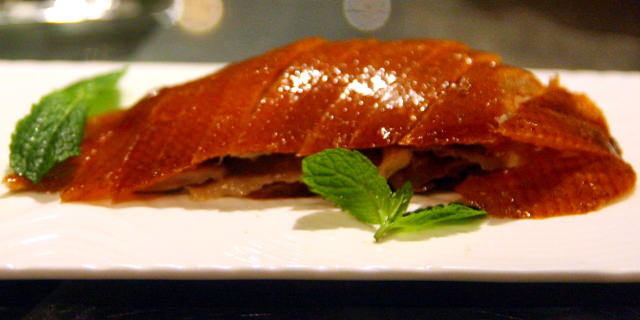
I ended up not taking notes at dadong because the dishes were just so good that I didn’t feel like writing them down. I would rather have my faulty memory conjure up the feelings of good food at dadong than empirically removing the magic of it. It’s THAT good.
There was a wait time at both places, however the wait time at dadong was considerably longer – 1 hour and 45 minutes.
Public Transport/Getting Around
I judge the “niceness” of a city based on the availability and ease of use of its public transport. By that count, Beijing scores really really well, at least around the city. We sampled buses, subways and taxis of Beijing, and they were all actually quite good.
Unlike buses in Brisbane or Sydney, where you’d have to buzz the driver to get off, buses in Beijing were kinda like trains – it has a set route, and stops at every designated stop, which is clearly labelled. At each bus stop, there was a route map and stop names. These stop names would also be announced on the bus. Also, if I am not mistaken, all buses are 2 yuan (I could be mistaken) per trip.
Like buses, subways in Beijing are also 2 yuan per trip (no matter the stop), which is great. I really really liked the subway system in Beijing, compared to those in other cities we visited due to that feature. The subway trains were also clean and on time, and throughout the week in Beijing it was consistently clean and on time for us.
Of course there were downsides to the public transport in China. After the first few days using buses, we switched almost entirely to subways. The reason? The people. The buses were almost always jam packed with people (in fact, we never had a bus trip where we were not squashed like sardines in a tin). At least there was breathing space in the subway stations.
I also had our hand in bicycling around the Tsinghua University area. Bicycles are cheap to rent, though a few things made me quite wary. Coming from a country with a sane direction of driving (i.e. left hand traffic, which is the sane one. Right hand traffic is plain insane), the right hand traffic nature of China was very taxing, even when crossing roads. Doing it on bicycles on the roads was a crazy experience. Thankfully once we were inside Tsinghua University, it became more relaxing to bike in there, without the hustle and bustle of traffic. The basic rule of traffic in Beijing when riding a bike is: people will generally let you go if you are brazen enough to push your way through. For the cowards like me, you wait till the traffic is clear, then quickly cross the road.
Asking directions had become an inside joke for us after a few times. When I visited Venice a number of years back, the most common directions we were given were “turn left, or right”. In Beijing, it’s very common for people to tell you that the place you want to go is “just 100 metres ahead”. The directions are usually correct. The distances however, is far from. There was once we walked about 5km in a straight line before reaching our destination. 100 metres, my foot. Soon, it became an inside joke to see how many “100m” responses we could get.
Speaking of directions, people in China, but especially Beijing, seem to be very tuned to the cardinal directions. It’s a very common thing to have directions that sound like “after you get out of the station, head north west for 100m, and you will arrive at your destination”. It was bewildering at first, how these people even knew what direction one would be facing. But the layout of the entire city having a North-South axis eventually made it easier to figure out the cardinal directions.
Complaints
My trip to Beijing was very very pleasant. If I have a complaint about Beijing, it would be the air quality. For most of my days in Beijing, I would return to my hotel room at the end of the day and blow my nose and find that I have black boogers. The first few nights I thought I had a nose bleed, but later inspection indicated that it was actually dust and dirt particles. Ew.
I’m also not really a fan of crowds. That seems to be entirely unavoidable in China though.
Along with the crowd thing, I’m also not really a fan of waiting to do things in Beijing. Almost everything has a queue and a wait time. Also, it’s not really a queue. People don’t really queue for stuff in Beijing, it’s more like let’s-mob-this-entrance-and-eventually-form-a-stream-like-structure. That of course led me to thinking about using computational fluid dynamics to model crowds, but that’s another story altogether.
Conclusion
I enjoyed my trip to Beijing a lot. I thought about a lot of things, and learned a lot more than I expected. It is a mix of the good parts of modern life (clean and on-time public transports), with a lot of old time charms (hutong, the old palaces, etc). I highly recommend Beijing as a city to visit.
I thought my crappy Mandarin (I speak Mandarin with an atrocious accent) would be a big hindering factor. It turns out it wasn’t. In fact, I could understand them, and they could understand me. Until I got to Luoyang…
